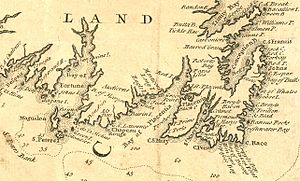| Battle of St. John's | |||||||
|---|---|---|---|---|---|---|---|
| Part of Queen Anne's War | |||||||
 Detail of 1744 map showing southeastern Newfoundland. "S Johns" is in the right center; Placentia (formerly Plaisance) is near the center. | |||||||
| |||||||
| Belligerents | |||||||
|
Mi'kmaq Abenakis |
| ||||||
| Commanders and leaders | |||||||
|
Joseph de Monbeton de Brouillan de Saint-Ovide Louis Denys de La Ronde |
Thomas Lloyd (POW) George Vane (POW) | ||||||
| Strength | |||||||
|
164 Marines Frigate Vénus |
80 troops about 400 colonists | ||||||
| Casualties and losses | |||||||
|
3 killed 11 wounded | 480 military and civilian prisoners | ||||||
The Battle of St. John's was the French capture of St. John's, the capital of the British colony of Newfoundland, on 1 January 1709 [O.S. 21 December 1708], during Queen Anne's War. A mixed and motley force of 164 men led by Joseph de Monbeton de Brouillan de Saint-Ovide,[1] king's lieutenant to Philippe Pastour de Costebelle, the French governor of Plaisance, quickly overwhelmed the British garrison at St. John's, and took about 500 prisoners.
Costebelle, whose resources were too limited to hold St. John's, destroyed its fortifications and abandoned it in April 1709. It was later reoccupied by the British. French colonial outposts in Newfoundland were abandoned after France ceded control of the island to Britain in the 1713 Treaty of Utrecht; most of the French settlers were relocated to Île-Royale, now known as Cape Breton Island.
- ^ Pothier, Bernard (1974). "Monbeton de Brouillan, Joseph de". In Halpenny, Francess G (ed.). Dictionary of Canadian Biography. Vol. III (1741–1770) (online ed.). University of Toronto Press.